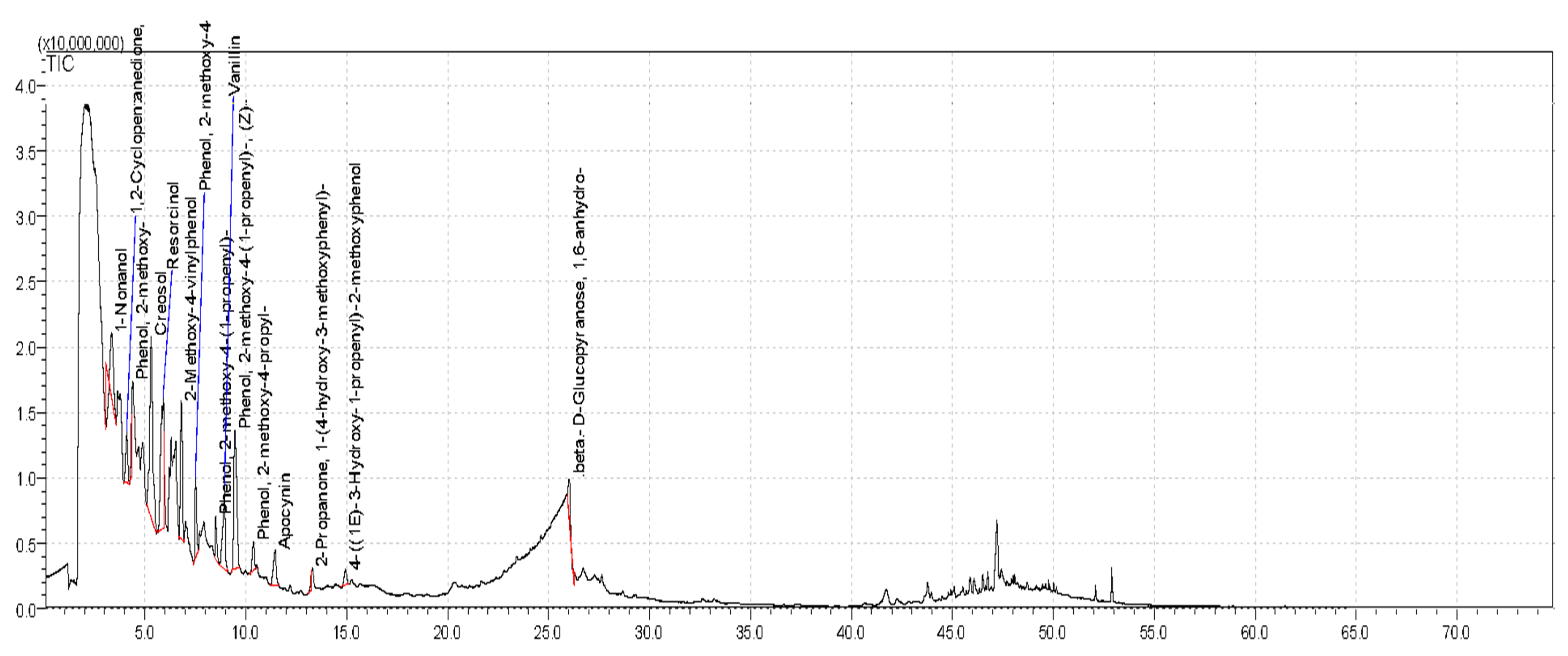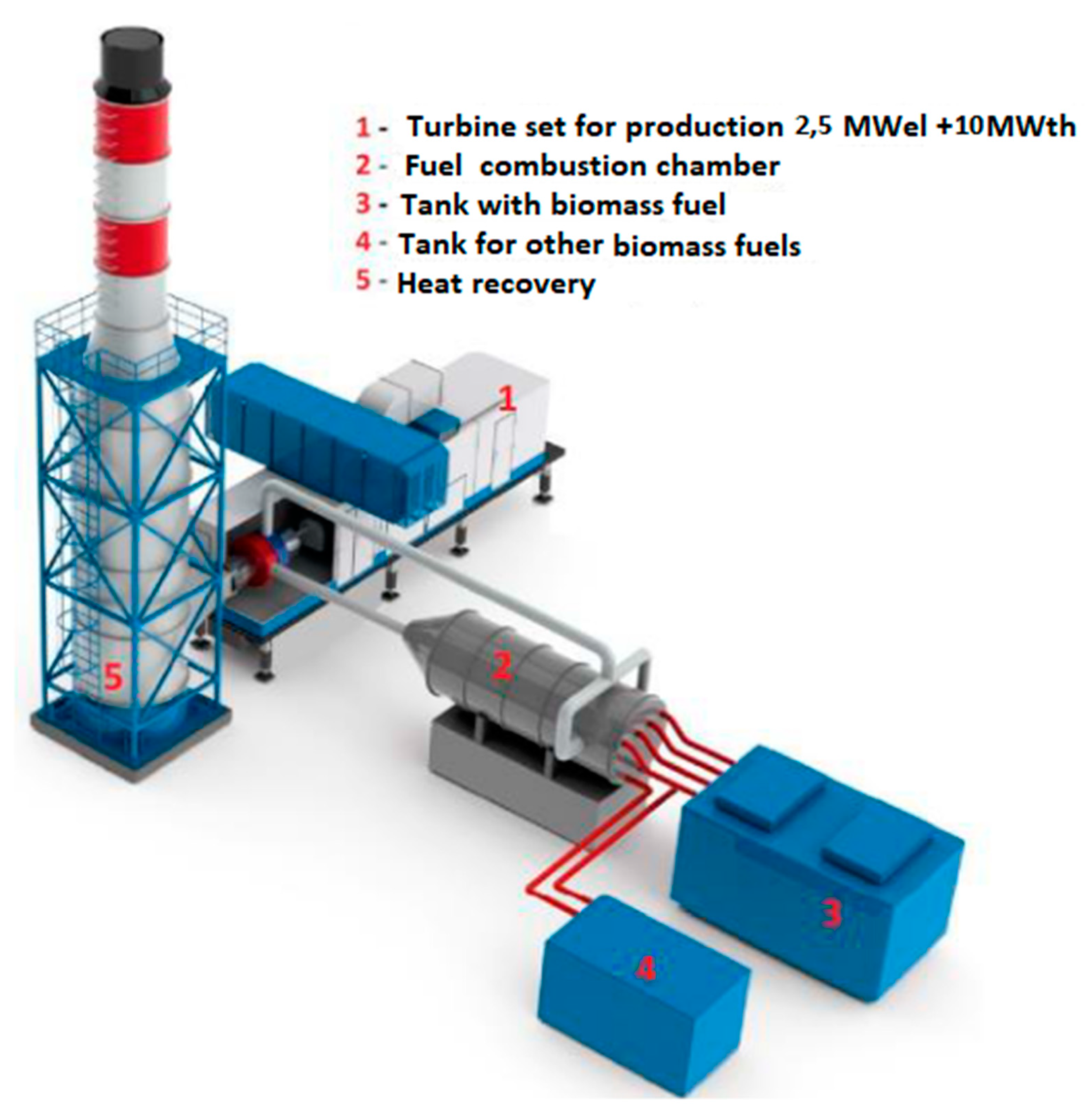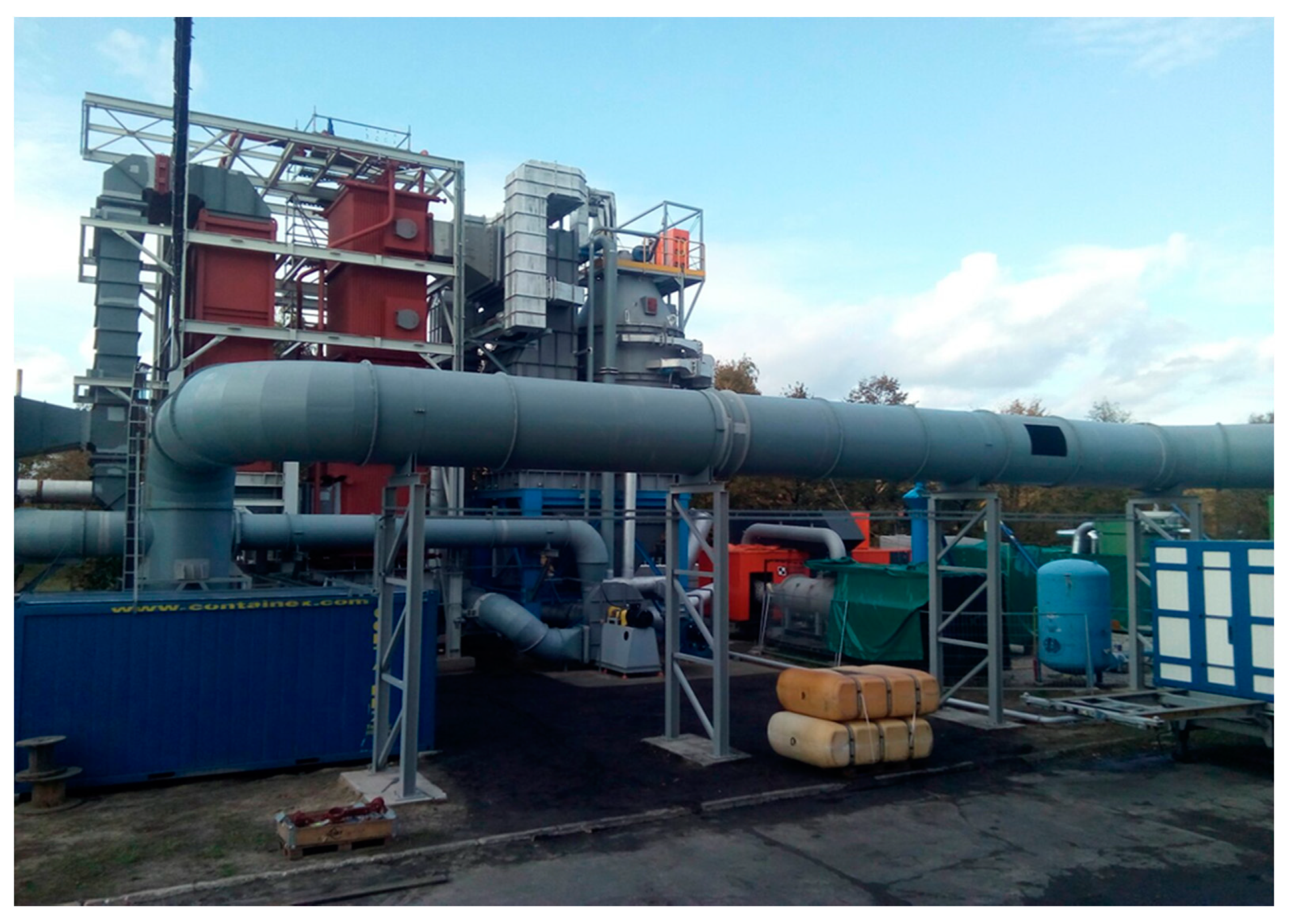Production of Electricity and Heat from Biomass Wastes Using a Converted Aircraft Turbine AI-20
Abstract
1. Introduction
2. Materials and Methods
2.1. Micronizing of the Materials
2.2. Moisture Measurement
2.3. Heating Values Measurements
2.4. Measurement of Ash Content
2.5. Measurements of Py-GC/MS
2.6. Electrical Energy and Heat Measurements
3. Results
3.1. Measurement of Selected Substances
3.2. Characteristics of the Block Diagram
3.3. Measurements of Py-GC/MS
3.4. Design and Construction Production Line
4. Discussion
5. Conclusions
Author Contributions
Funding
Institutional Review Board Statement
Informed Consent Statement
Data Availability Statement
Acknowledgments
Conflicts of Interest
References
- Siddiqui, S.; Friedman, D.; Alper, J. Opportunities and Obstacles in Large-Scale Biomass Utilization: The Role of the Chemical Sciences and Engineering Communities: A Workshop Summary; The National Academies Press: Washington, DC, USA, 2012; p. 60. Available online: https://www.ncbi.nlm.nih.gov/books/NBK115434/pdf/Bookshelf_NBK115434.pdf (accessed on 12 March 2020).
- Wickwire, S. Biomass Combined Heat and Power Catalog of Technologies U. S. Environmental Protection Agency Combined Heat and Power Partnership. 2007; p. 122. Available online: https://www.epa.gov/sites/production/files/2015-07/documents/biomass_combined_heat_and_power_catalog_of_technologies_v.1.1.pdf (accessed on 20 April 2020).
- Bridgwater, A.V.; Alcala, A.; Gyftopoulou, M.E. Biomass-based small and micro combined heat and power (CHP) systems: Application and status in the United Kingdom. In Small and Micro Combined Heat and Power (CHP) Systems; Woodhead Publishing Series in Energy: Sawston, UK, 2011; pp. 427–458. [Google Scholar]
- Freiberg, A.; Scharfe, J.; Murta, V.C.; Seidler, A. The use of biomass for electricity generation: A scoping review of health effects on humans in residential and occupational settings. Int. J. Environ. Res. Public Health 2018, 15, 354. [Google Scholar] [CrossRef]
- Durlik, I. Inżynieria Zarządzania cz. I, 7th ed.; Placet: Warsaw, Poland, 2007; p. 311. ISBN 9788374881142. [Google Scholar]
- Brilman, J. Nowoczesne Koncepcje i Metody Zarządzania; Polskie Wydawnictwo Ekonomiczne: Warsaw, Poland, 2001; p. 478. [Google Scholar]
- Borowski, P.F. Development strategies for electric utilities. Acta Energetica 2016, 4, 16–21. [Google Scholar] [CrossRef]
- IEA. Energy Policies of IEA Countries: Poland 2016 Review. Country Report—January 2017; International Energy Agency. 2017. Available online: https://www.apgef.com/wp-content/uploads/2017/03/Energy_Policies_of_IEA_Countries_Poland_2016_Review.pdf (accessed on 1 October 2020).
- Browers, H.; Oei, P. The political economy of coal in Poland: Drivers and barriers for a shift away from fossil fuels. Energy Policy 2020, 144, 111621. [Google Scholar] [CrossRef]
- Gawlik, L. The Polish power industry in energy transformation process. Miner. Econ. 2017, 31, 229–237. [Google Scholar] [CrossRef]
- Gradziuk, P.; Gradziuk, B. Renewable energy sources as a development opportunity for peripheral areas. Econ. Reg. Stud. 2020, 13, 184–198. [Google Scholar] [CrossRef]
- PAP. Morawiecki: Agreement with Miners—A Breakthrough Polish Press Agency. 2020. (in Polish). Available online: https://www.pap.pl/en/news/news,507650,unions-coal-company-reach-accord-on-polish-mining-group.html (accessed on 1 October 2020).
- PSE. The Achieved Power Structure in National Power Grid State on the 31.12.2019; Report of KSE. 2020. (in Polish). Available online: https://www.pse.pl/dane-systemowe/funkcjonowanie-rb/raporty-roczne-z-funkcjonowania-kse-za-rok/raporty-za-rok-2019#t1_1 (accessed on 1 October 2020).
- Baum, R.; Wajszczuk, K.; Pepliński, B.; Wawrzynowicz, J. Potential for agricultural biomass production for energy purposes in Poland: A review. Contemp. Econ. 2013, 7, 63–74. [Google Scholar]
- Nurek, T.; Gendek, A.; Roman, K.; Dąbrowska, M. The impact of fractional composition on the mechanical properties of agglomerated logging residues. Sustainability 2020, 12, 6120. [Google Scholar] [CrossRef]
- Nurek, T.; Gendek, A.; Roman, K. Forest residues as a renewable source of energy: Elemental composition and physical properties. BioResources 2020, 14, 6–20. [Google Scholar] [CrossRef]
- Krzyżaniak, M.; Stolarski, M.J.; Warmiński, K. Life cycle assessment of poplar production: Environmental impact of different soil enrichment methods. J. Clean. Prod. 2019, 206, 785–796. [Google Scholar] [CrossRef]
- Aberilla, J.M.; Gallego-Schmid, A.; Azapagic, A. Environmental sustainability of small-scale biomass power technologies for agricultural communities in developing countries. Renew. Energy 2019, 141, 493–506. [Google Scholar] [CrossRef]
- Rikkonen, P.; Tapio, P.; Rintamaki, H. Visions for small-scale renewable energy production on Finnish farms—A Delphi study on the opportunities for new business. Energy Policy 2019, 129, 939–948. [Google Scholar] [CrossRef]
- Kishore, V.; Bhandari, P.M.; Gupta, P. Biomass energy technologies for rural infrastructure and village power—Opportunities and challenges in the context of global climate change concerns. Energy Policy 2004, 32, 801–810. [Google Scholar] [CrossRef]
- Flizikowski, J.; Topoliński, T.; Opielak, M.; Tomporowski, A.; Mroziński, A. Badania i analiza eksploatacyjnych charakterystyk mikronizatora. Energetycznej Biomasy 2015, 7, 1. [Google Scholar]
- PN-EN 13183-1:2004. Wilgotność Sztuki Tarcicy—Część 1: Oznaczanie Wilgotności Metodą Suszarkowo-Wagową. Available online: https://sklep.pkn.pl/pn-en-13183-1-2004p.html (accessed on 5 May 2020).
- Grzybek, A.; Kowalczyk, K.; Janicka, A. Dobór Technologii Wykorzystującej Biomasę do Produkcji Energii; CMOLAS: Cmolas, Poland, 2007; p. 20. [Google Scholar]
- Babiarz, M.; Bednarczuk, Ł. Popiół ze spalania biomasy i jego wykorzystanie. WPIA AGH, p.3. Available online: http://home.agh.edu.pl/~madrygas/Surowce%20energetyczne%20i%20paliwa%20-%20laboratorium/Stale/Cw%203.%20Cieplo%20spalania%20i%20wartosc%20opalowa%20paliw%20stalych.pdf (accessed on 6 May 2020).
- Politechnika Warszawska. Technologia Chemiczna—Surowce i Nośniki Energii; Politechnika Warszawska: Warsaw, Poland, 2010; p. 4. [Google Scholar]
- Nurek, T.; Roman, K.K. Effect of mineral matter content on specific density of forest biomass. Ann. Warsaw Univ. Life Sci. SGGW Agricult. Agricult. Forest Eng. 2014, 64, 109–116. [Google Scholar]
- Roman, K. Selection of Technical Parameters of the Forest Biomass Briqueling Process. Ph.D. Thesis, Warsaw University of Life Sciences (WULS), Warsaw, Poland, 2017; p. 138. [Google Scholar]
- Diab, T.M.; Haelssig, J.B.; Pegg, J.M. The behaviour of wood crib fires under free burning and fire whirl conditions. Fire Safety J. 2020, 112, 102941. [Google Scholar] [CrossRef]
- Kowalska, G.B.; Kacprowska, J.; Gogacz, I.; Jurgaś, A. Energia ze Źródeł Odnawialnych r; GUS: Warsaw, Poland, 2012; pp. 13–14. [Google Scholar]
- Błasiak, W.; Moberg, G.; Grimbrandt, J. Redukcja tlenków azotu oraz optymalizacja spalania w komorach kotłów za pomocą asymetrycznego systemu podawania powietrza wtórnego. In Proceedings of the 10 Międzynarodowa Konferencja Technik Grzewczych, Gothenburg, Sweeden, 13–18 August 2006. [Google Scholar]
- Pasyniuk, P. Prawne, Technologiczne, Środowiskowe i Ekonomiczne Uwarunkowania Rozwoju Produkcji Odnawialnych Źródeł Energii w Polsce Opartych na Biomasie Pochodzenia Rolniczego; IBMER: Warsaw, Poland, 2008; p. 12. [Google Scholar]
- Borowski, P.F. Zonal and nodal models of energy market in European Union. Energies 2020, 13, 4182. [Google Scholar] [CrossRef]
- Kupczyk, A.; Mączyńska-Sęczek, J.; Golisz, E.; Borowski, P.F. Renewable energy sources in transport on the example of methyl esters and bioethanol. Processes 2020, 8, 1610. [Google Scholar] [CrossRef]
- Borowski, P. Development strategy of electricity production from biomass. In Proceedings of the International Congress on Mechanization and Energy in Agricultural, Antalya, Turkey, 14–17 October 2008; pp. 438–440. [Google Scholar]
- KOBIZE. Wartości Opałowe (WO) i Wskaźniki Emisji CO2 (WE) w Roku 2016 do Raportowania w Ramach Systemu Handlu Uprawnieniami do Emisji za rok 2019. 2018. Available online: https://www.kobize.pl/uploads/materialy/WO_i_WE_do_monitorowania-ETS-2019.pdf (accessed on 23 May 2020).
- ECiZ. Energetyka Cieplna i Zawodowa; 3/2010 (448) 2010; ECiZ: Warsaw, Poland, 2010; p. 41, ISSN 1734-7823. [Google Scholar]
- Borowski, P.F. Nexus between water, energy, food and climate change as challenges facing the modern global, European and Polish economy. AIMS Geosci. 2020, 6, 397–421. [Google Scholar] [CrossRef]
- Feledyn-Szewczyk, B.; Radzikowski, P.; Stalenga, J.; Matyka, M. Comparison of the effect of perennial energy crops and arable crops on earthworm populations. Agronomy 2019, 9, 675. [Google Scholar] [CrossRef]
- U.S. Department of Energy Federal Energy Management Program (FEMP). Biomass for Electricity Generation. 2016. Available online: https://www.wbdg.org/resources/biomass-electricity-generation (accessed on 4 October 2020).
- Hryniewicz, M.; Grzybek, A. Straw surplus accessible for Energy purposes in 2016. Prob. Agricult. Eng. 2017, 97, 15–31. (In Polish) [Google Scholar]
- 2050 Long-Term Strategy. Available online: https://ec.europa.eu/clima/policies/strategies/2050_en (accessed on 22 March 2020).
- Renewable Energy—Recast to 2030 (RED II). Available online: https://ec.europa.eu/jrc/en/jec/renewable-energy-recast-2030-red-ii#:~:text=In%20December%202018,%20the%20revised%20renewable%20energy%20directive,consumption%20by%202030%20has%20been%20raised%20to%2032% (accessed on 12 December 2020).
- Raslavičius, L.; Grzybek, A.; Dubrovin, V. Bioenergy in Ukraine-Possibilities of rural development and opportunities for local communities. Energy Policy 2011, 39, 3370–3379. [Google Scholar] [CrossRef]







| Stage | Temperature °C |
|---|---|
| Drying | 100 1 |
| Gasification | about 200 1 |
| Burning | about 400 1,2 |
| Burning charcoal | >500 1 |
| Material (Name) | Lower Heating Value (MJ/kg) | Ash (%) | Moisture (%) | Higher Heating Value (MJ/kg) | Ash Amount for 80% Work during Year (6400 h)(t) |
|---|---|---|---|---|---|
| Sunflower husk | 17.27 | 4.09 | 9.41 | 18.52 | 448 |
| Oat husk | 15.16 | 1.89 | 11.76 | 16.58 | 230 |
| Wheat straw | 16.74 | 1.70 | 12.08 | 18.05 | 186 |
| Miscanthus | 16.72 | 1.20 | 11.83 | 18.91 | 134 |
| Hay | 17.10 | 5.70 | 20.00 | 18.20 | 557 |
| Wood chips | 10.40 | 0.80 | 40.00 | 19.40 | 96 |
| Willow | 15.30 | 1.45 | 19.02 | 19.47 | 160 |
| Poplar | 7.82 | 4.70 | 48.80 | 9.37 | 640 |
| Material | Fuel Amount | Dry Fuel Amount | Ash Amount | Fuel Amount per Year | Ash Amount Created per Year |
|---|---|---|---|---|---|
| (Name) | (t h−1) | (t h−1 d.m.) | (kg h−1) | (t year−1) | (kg year−1) |
| Sunflower husk | 1.9 | 1.7 | 70 | 12 160 | 448,000 |
| Oat husk | 2.2 | 1.9 | 36 | 14 080 | 230,400 |
| Wheat straw | 1.9 | 1.7 | 29 | 12 160 | 185,600 |
| Miscanthus | 1.9 | 1.7 | 21 | 12 160 | 134,400 |
| Hay | 1.9 | 1.5 | 87 | 12 160 | 556,800 |
| Wood chips | 3.1 | 1.9 | 15 | 19 840 | 96,000 |
| Willow | 2.1 | 1.7 | 25 | 13 440 | 160,000 |
| Poplar | 4.2 | 2.1 | 100 | 26 880 | 640,000 |
| Substance Name | Retention Time | Beginning of Retention Time | End of Retention Time | Area | Area % | Height | Height % | Height Ratio of Area to Height |
|---|---|---|---|---|---|---|---|---|
| 5-Hydroxymethylfurfural | 6.302 | 5.970 | 6.653 | 58,223,805 | 13.95 | 3,103,757 | 13.56 | 18.76 |
| 4-Hydroxy-3-methylacetophenone | 6.747 | 6.593 | 7.158 | 33,636,429 | 8.06 | 2,712,507 | 11.85 | 12.40 |
| 3-Allyl-6-methoxyphenol | 7.478 | 7.292 | 7.605 | 7,841,898 | 1.88 | 1,299,014 | 5.67 | 6.04 |
| trans-Isoeugenol | 9.369 | 9.268 | 9.730 | 50,166,012 | 12.02 | 5,457,473 | 23.84 | 9.19 |
| Phenol, 2-methoxy-4-propyl- | 10.206 | 10.027 | 10.383 | 8,757,989 | 2.10 | 1,327,823 | 5.80 | 6.60 |
| Propan-2-one, 1-(4-isopropoxy-3-methoxyphenyl)- | 13.130 | 12.850 | 13.430 | 10,909,220 | 2.61 | 912,706 | 3.99 | 11.95 |
| 2-Propenal, 3-(4-hydroxy-3-methoxyphenyl)- | 23.108 | 22.743 | 23.322 | 19,921,380 | 4.77 | 1,563,993 | 6.83 | 12.74 |
| .beta.-D-Glucopyranose, 1,6-anhydro- | 26.885 | 25.863 | 27.453 | 2,21×108 | 52.89 | 6,079,678 | 26.54 | 36.30 |
| 3-(3-Hydroxy-4-methoxyphenyl)-l-alanine | 41.648 | 41.338 | 41.902 | 7,171,324 | 1.72 | 438,929 | 1.92 | 16.34 |
| Substance Name | Retention Time | Beginning of Retention Time | End of Retention Time | Area | Area % | Height | Height % | Height Ratio of Area to Height |
|---|---|---|---|---|---|---|---|---|
| 1-Nonanol | 3.338 | 3.072 | 3.578 | 29,843,409 | 4.45 | 4,760,529 | 5.58 | 6.27 |
| 1,2-Cyclopentanedione, 3-methyl- | 4.106 | 3.955 | 4.237 | 27,646,010 | 4.12 | 4,011,657 | 4.70 | 6.89 |
| Phenol, 2-methoxy- | 4.330 | 4.225 | 4.330 | 8,159,169 | 1.22 | 4,719,840 | 5.53 | 1.73 |
| Creosol | 5.312 | 5.095 | 5.553 | 142,920,667 | 21.30 | 13,877,478 | 16.25 | 10.30 |
| Resorcinol | 5.918 | 5.635 | 5.943 | 105,583,215 | 15.74 | 10,047,241 | 11.78 | 10.51 |
| 2-Methoxy-4-vinylphenol | 6.802 | 6.683 | 6.950 | 70,451,490 | 10.50 | 10,534,477 | 12.35 | 6.69 |
| Phenol, 2-methoxy-4-(2-propenyl)-, acetate | 7.504 | 7.390 | 7.662 | 30,076,157 | 4.48 | 6,236,743 | 7.31 | 4.82 |
| Phenol, 2-methoxy-4-(1-propenyl)- | 8.500 | 8.423 | 8.687 | 17,917,074 | 2.67 | 3,273,683 | 3.84 | 5.47 |
| Vanillin | 8.949 | 8.687 | 9.080 | 53,563,972 | 7.98 | 6,441,123 | 7.55 | 8.32 |
| Phenol, 2-methoxy-4-(1-propenyl)-, (Z)- | 9.453 | 9.280 | 9.688 | 106,849,808 | 15.93 | 10,662,932 | 12.50 | 10.02 |
| Phenol, 2-methoxy-4-propyl- | 10.376 | 10.202 | 10.497 | 15,976,600 | 2.38 | 2,157,416 | 2.53 | 7.41 |
| Apocynin | 11.440 | 11.242 | 11.610 | 25,925,624 | 3.86 | 2,682,291 | 3.14 | 9.67 |
| 2-Propanone, 1-(4-hydroxy-3-methoxyphenyl)- | 13.258 | 13.075 | 13.258 | 5,674,677 | 0.85 | 1,557,616 | 1.83 | 3.64 |
| 4-((1E)-3-Hydroxy-1-propenyl)-2-methoxyphenol | 14.947 | 14.733 | 15.100 | 10,811,308 | 1.61 | 1,204,065 | 1.41 | 8.98 |
| .beta.-D-Glucopyranose, 1,6-anhydro- | 26.018 | 25.928 | 26.273 | 19,509,501 | 2.91 | 3,159,530 | 3.70 | 6.17 |
Publisher’s Note: MDPI stays neutral with regard to jurisdictional claims in published maps and institutional affiliations. |
© 2021 by the authors. Licensee MDPI, Basel, Switzerland. This article is an open access article distributed under the terms and conditions of the Creative Commons Attribution (CC BY) license (http://creativecommons.org/licenses/by/4.0/).
Share and Cite
Roman, K.; Barwicki, J.; Hryniewicz, M.; Szadkowska, D.; Szadkowski, J. Production of Electricity and Heat from Biomass Wastes Using a Converted Aircraft Turbine AI-20. Processes 2021, 9, 364. https://doi.org/10.3390/pr9020364
Roman K, Barwicki J, Hryniewicz M, Szadkowska D, Szadkowski J. Production of Electricity and Heat from Biomass Wastes Using a Converted Aircraft Turbine AI-20. Processes. 2021; 9(2):364. https://doi.org/10.3390/pr9020364
Chicago/Turabian StyleRoman, Kamil, Jan Barwicki, Marek Hryniewicz, Dominika Szadkowska, and Jan Szadkowski. 2021. "Production of Electricity and Heat from Biomass Wastes Using a Converted Aircraft Turbine AI-20" Processes 9, no. 2: 364. https://doi.org/10.3390/pr9020364
APA StyleRoman, K., Barwicki, J., Hryniewicz, M., Szadkowska, D., & Szadkowski, J. (2021). Production of Electricity and Heat from Biomass Wastes Using a Converted Aircraft Turbine AI-20. Processes, 9(2), 364. https://doi.org/10.3390/pr9020364







